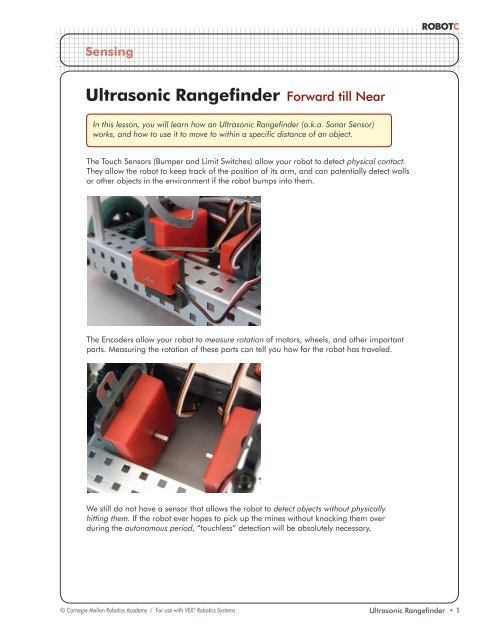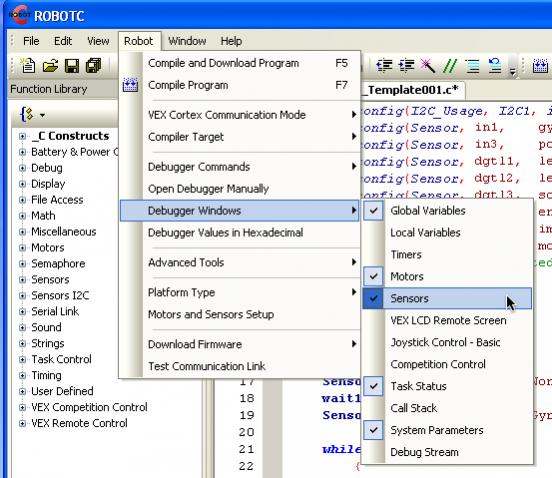
#Robotc ultrasonic sensor pdf
There are specific steps in eas圜 needed to start the whole ball rolling, and this PDF walks you through them. The diagrams are for the old, PIC controller, but the necessary steps and setup are basically unchanged. Here’s a really helpful Ultrasonic Sensor presentation from San Jose State University that I downloaded I-don’t-know-when.

In the eas圜 configuration window, you must flip the Input wire’s port direction, so that the teeny arrow is pointing out from the teeny white circle. In the RobotC “Motors and Sensors” window, you set the sensor to return inches or centimeters once you tell it where the Input wire is plugged, it will prompt you for where the Output wire is plugged.Įas圜: You must plug both wires into digital ports, but it’s not necessary that they be neighboring ports. RobotC: Both of these wires get plugged into adjacent cortex Digital ports, with the Input wire in the lower-numbered port and Output wire in the higher-numbered port. The sensor gets instructions in from the cortex to send a pulse via the Input wire it returns the rebounded signal via the Output wire. Basically, these Input and Output labels are from the sensor’s perspective. Contrary to what a reasonable person might think, the “Input” wire is the one that sends out the pulse signal, and “Output” receives the signal back. Looking at the sensor you’ll see that the 2 wires have labels: “Input” and “Output” (photo, right). This step will help you calibrate your sensor, understand how straight it has to be pointing at an object to work right, figure out what type of objects work well (or don’t), and double-check that you have a working, non-defective sensor-before you go to the trouble of attaching it to your robot. Using the debugger window (online window for eas圜 users or sending the value to an LCD screen), we walked around the room with the test setup, pointing the sensor at different objects and comparing the sensor’s value to what we got using a tape measure. Test Test Testīefore we attached our sensor to our robot last week, we hooked it up to a test cortex. So oftentimes in your programming you’ll want to add the condition “…and sensorValue > 0” to make sure that you’re not including junk data in your calculations or comparisons. What about –1? I keep getting –1 when I’m pointing the sensor around the room what does that mean? A value of –1 means that the object is out of range/too far away. Here is a really great YouTube tutorial on programming the ultrasonic in eas圜!) ( Note to eas圜 users: I know that this sensor can report in inches or centimeters, but I am unsure as to where that setting is be on the lookout for it in your GetSensor or StartSensor blocks. Once you tell your setup that you’re using millimeters/centimeters/inches, the output from the sensor is very straightforward: the value the sensor gives you is the number of mm/cm/in to the object in front. If you’re interested in additional technical details on this component, this is a very helpful blog post, as well as this VEX Forum thread, and this one too. By the 50ms mark, the previously-sent sound waves have dissipated enough that they do not risk interfering with the next pulse or measurement. The pulse that gets sent out is 250 microseconds long, and it gets sent out on a regular schedule, every 50 milliseconds. One of the two “eyes” on the front of the sensor sends the signal out, and the other one receives the signal back (see the sensor’s info sheet PDF for the details). The ultrasonic sensor has the ability to measure objects between 3cm and 3m away (1.5 inches to ~10 feet). Using the amount of time it takes for the sound wave to bounce back, the sensor calculates the distance from itself to the object in front of it. It sends out a sound wave and catches the rebound. The ultrasonic sensor works like a bat’s or dolphin’s echolocation, or a submarine’s sonar.



Moving on to the list of more advanced sensors, here we go on the Ultrasonic Range Finder.


 0 kommentar(er)
0 kommentar(er)
